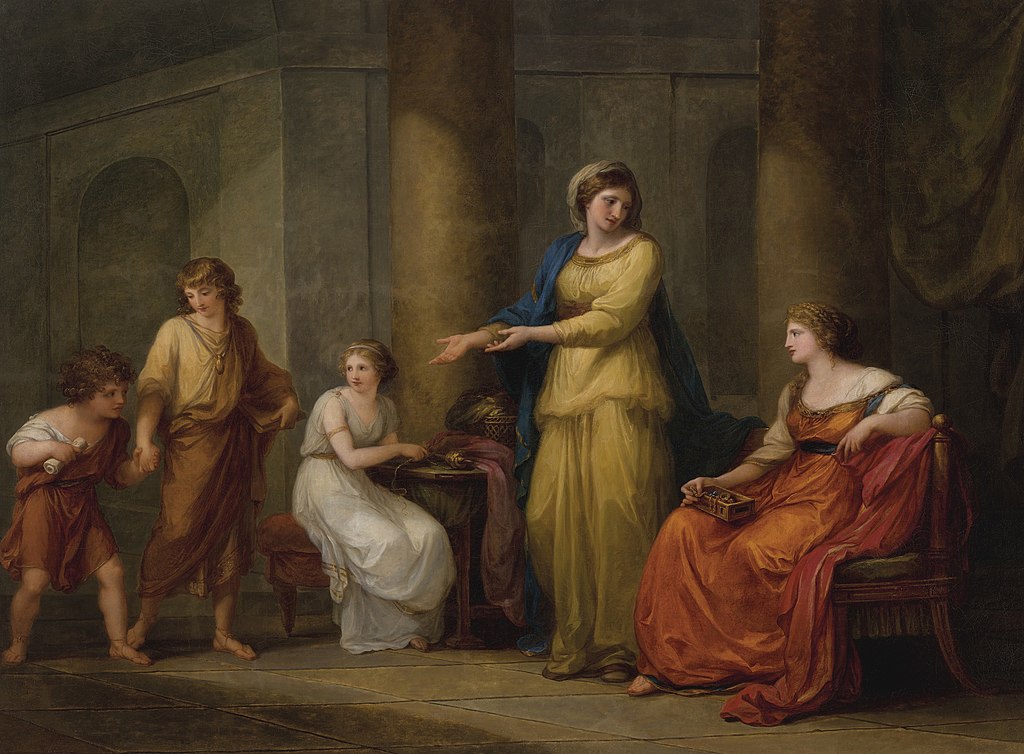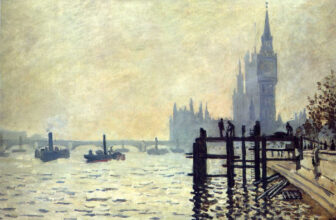
A Masterpiece of Neoclassical Symbolism and Maternal Virtue
Angelica Kauffmann’s Cornelia, Mother of the Gracchi is not only a triumph of 18th-century painting but also a powerful allegory of virtue, motherhood, and republican ideals. This Neoclassical painting, created in 1785, remains one of the artist’s most iconic works. It vividly captures a historical anecdote from ancient Rome and transforms it into a moral lesson about values, character, and the importance of civic duty. The painting serves as both a political statement and a cultural artifact, rooted in Enlightenment principles that were gaining prominence during Kauffmann’s time.
This in-depth analysis delves into the narrative and historical context of the painting, its artistic style, symbolism, and interpretation, as well as the life and legacy of Angelica Kauffmann, one of the most distinguished female artists of the 18th century. Let us explore what makes Cornelia, Mother of the Gracchi such a resonant and timeless work of art.
The Painter: Angelica Kauffmann
Maria Anna Angelika Kauffmann (1741–1807) was a Swiss-born painter who achieved remarkable acclaim across Europe during a period when few women were recognized in the fine arts. She was a child prodigy, trained by her father, Joseph Johann Kauffmann, and later educated in Italy, where she absorbed the classical styles and motifs that would define her mature work.
Kauffmann’s career flourished in Rome and London. She was a founding member of the Royal Academy of Arts in London in 1768, one of only two female founding members. Her oeuvre is rich with historical, mythological, and literary themes, executed with elegance and emotional clarity. Kauffmann’s style was deeply informed by the Neoclassical movement, which sought to revive the ideals of classical antiquity: harmony, moral clarity, and civic virtue.
Among her many masterpieces, Cornelia, Mother of the Gracchi stands out for its moral depth and emotional resonance. The painting not only reflects Kauffmann’s technical prowess but also her commitment to Enlightenment values and the education of public taste through art.
The Subject of the Painting: Who Was Cornelia?
Cornelia Africana was a noblewoman of ancient Rome, the daughter of Scipio Africanus (the famed general who defeated Hannibal) and the mother of Tiberius and Gaius Gracchus, known collectively as the Gracchi brothers. The Gracchi would become key figures in Roman history, renowned for their efforts to reform the Roman Republic in favor of the common people. Cornelia, widowed at a young age, refused to remarry and dedicated her life to raising her children with a strict sense of moral and civic duty.
The story depicted in the painting derives from a famous Roman anecdote: when a wealthy woman visits Cornelia and shows off her luxurious jewelry, she asks to see Cornelia’s own treasures. Cornelia responds by presenting her sons and declaring, “These are my jewels.” This tale became emblematic of Roman matronly virtue, placing familial values and the cultivation of moral character above material wealth.
What is Happening in the Cornelia, Mother of the Gracchi Painting?
In Kauffmann’s depiction, the scene is calm yet emotionally powerful. Cornelia is positioned at the center of the composition, dressed in classical Roman attire, her posture composed and dignified. Her arm gestures toward her two sons, Tiberius and Gaius, who stand beside her, suggesting pride and affection. On the opposite side of the painting, the visiting woman displays her fine jewelry, held delicately in her hands or a jewelry box, while looking at Cornelia with a mix of curiosity and mild astonishment.
Cornelia’s modest surroundings, her simple clothing, and the noble bearing of her children contrast sharply with the ornate finery of the visitor. The compositional choice emphasizes the dichotomy between inner virtue and external display. The expression on Cornelia’s face is serene but firm, reinforcing the message that true value lies not in material possessions but in moral and intellectual legacy.
Symbolism and Interpretation
At its heart, Cornelia, Mother of the Gracchi is a painting about values, specifically, Roman virtues of pietas (duty), gravitas (dignity), and maternal devotion. The painting is laden with symbolic elements that enrich its message:
Cornelia’s Gesture: Her open hand toward her children signifies not only presentation but dedication. She does not merely show her sons; she offers them to the future of the Republic.
Jewelry Box: Held by the visitor, it represents the superficial values of wealth, vanity, and social status. It contrasts with the “living treasures” of Cornelia, her sons, who symbolize future reform and ideal citizenship.
Attire and Setting: The classical clothing and architecture signal a return to antiquity and the ideals of the Roman Republic. This reinforces the painting’s Neoclassical roots and the Enlightenment belief that ancient virtues were models for contemporary society.
The Children: Although still young, they are depicted with features of nobility and intelligence. Their presence as Cornelia’s “jewels” emphasizes the belief that proper education and parenting are more valuable than riches.
The painting functions as a didactic tool, aimed at educating its viewers, particularly women, on the importance of moral upbringing, modesty, and public service. Kauffmann subtly challenges prevailing gender norms by presenting Cornelia not only as a good mother but also as a moral philosopher and patriot.
Neoclassicism and Artistic Style
Cornelia, Mother of the Gracchi is a quintessential Neoclassical painting. Emerging in the mid-18th century, Neoclassicism was a response to the ornate and decadent Rococo style. Artists like Kauffmann turned to the aesthetics and values of ancient Greece and Rome, emphasizing rationality, clarity, and idealized beauty.
Key Features of Neoclassicism in the Painting:
Clean lines and balanced composition: The figures are arranged in a pyramidal structure, drawing the eye naturally to Cornelia at the center.
Emphasis on moral themes: Neoclassical art was often didactic, meant to improve public morals. This painting does so by extolling maternal and civic virtue.
Muted color palette: The soft, harmonious colors lend the painting a calm, reflective tone, appropriate to its subject.
Idealized figures: Cornelia and her sons are depicted with idealized, classical beauty, reflecting Enlightenment notions of rationality and perfection.
Kauffmann also imbues the painting with an emotional subtlety that distinguishes her work from that of her male contemporaries. There is warmth and humanity in Cornelia’s expression, a reminder that moral fortitude does not preclude tenderness.
Cultural and Political Context
The Enlightenment era, during which Kauffmann painted Cornelia, was deeply concerned with questions of morality, education, and the public good. In this context, the painting can be seen as part of a larger movement that sought to reshape society through reason and virtue.
For women especially, Cornelia became a model of female excellence, educated, stoic, self-sacrificing, and a key participant in the moral upbringing of the next generation. The painting thus resonated not only as a historical tableau but as a contemporary ideal. It also subtly critiques the frivolity and materialism associated with aristocratic society, advocating instead for a return to republican values.
Where Is the Cornelia, Mother of the Gracchi Painting Today?
Cornelia, Mother of the Gracchi by Angelica Kauffmann is currently housed in the Virginia Museum of Fine Arts (VMFA) in Richmond, Virginia. It is one of the museum’s most treasured examples of Neoclassical painting and is frequently highlighted in exhibitions that explore themes of Enlightenment art, gender, and virtue.
The painting is accessible to the public and is often featured in academic discussions, art history courses, and feminist studies due to its layered meanings and its place in the canon of women artists who succeeded despite the restrictions of their time.
The enduring relevance of Cornelia, Mother of the Gracchi lies in its layered storytelling and moral clarity. In an age of materialism and spectacle, the painting reminds viewers of deeper values, integrity, selflessness, and the profound influence of maternal care. It speaks to educators, parents, citizens, and artists alike.
Moreover, Angelica Kauffmann’s authorship adds a feminist dimension to the work. By choosing a story about a strong, morally upright woman and painting it with both technical mastery and emotional insight, Kauffmann affirms the power of women not only as subjects of art but as creators of culture.
Her Cornelia is not passive or ornamental, she is an agent of history, shaping the future through her children and her values. In this way, the painting becomes not only a celebration of motherhood but also a celebration of women’s capacity to influence the public sphere, even within private roles.
Cornelia, Mother of the Gracchi by Angelica Kauffmann is a painting that transcends its canvas. It is a meditation on values, a tribute to maternal virtue, and a beacon of Neoclassical ideals. Rich with symbolism and painted with a clarity and grace that only Kauffmann could achieve, it remains one of the most important and beloved depictions of classical history in Western art.
Through Cornelia’s simple yet profound declaration, “These are my jewels”, Kauffmann reminds us that the most precious legacies are not things, but people; not possessions, but principles. This timeless message continues to inspire, making the painting as relevant today as it was in the 18th century.




